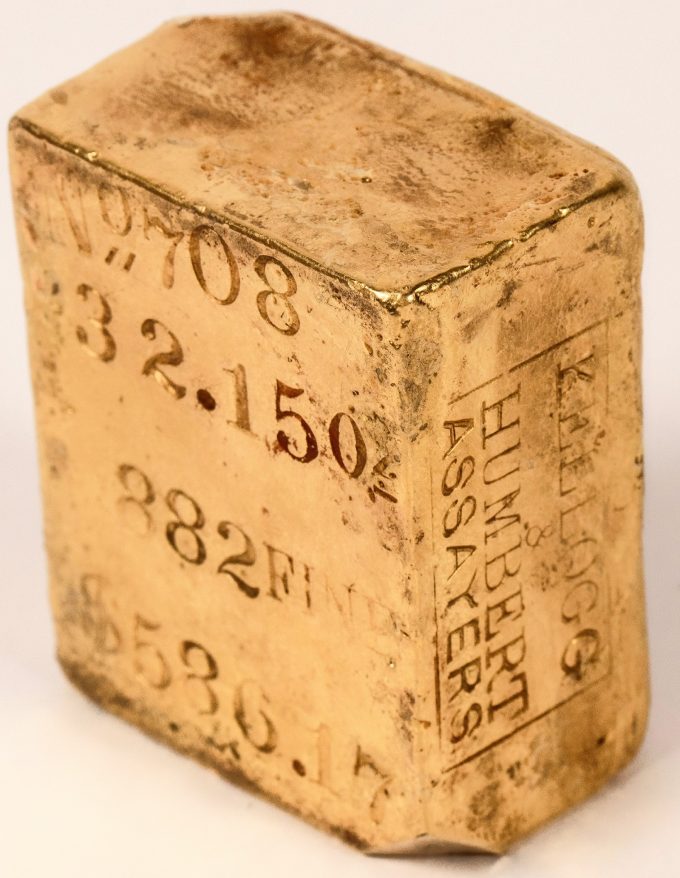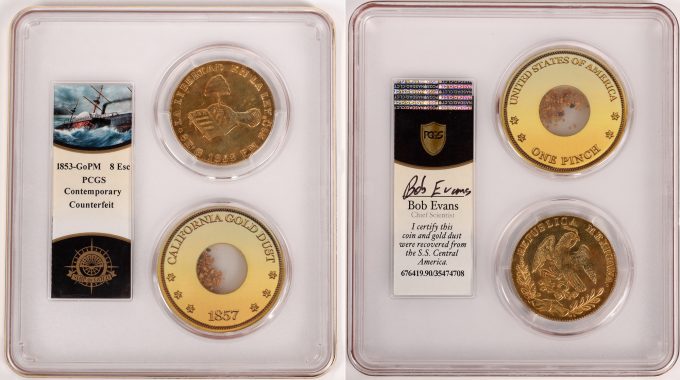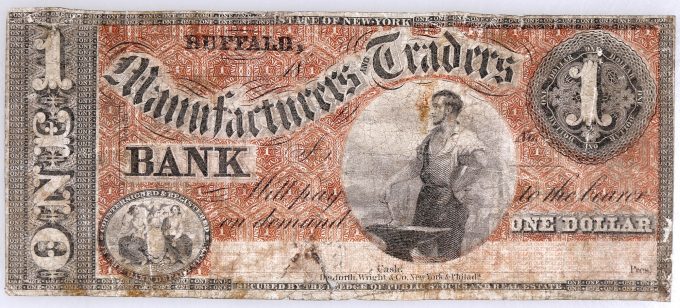Historic numismatic items, including a nearly two-pound Kellogg & Humbert assayer’s gold ingot, are included in the second and final auction of never-before-offered California Gold Rush artifacts recovered from the 1857 sinking of the fabled "Ship of Gold," the S.S. Central America. The auction will be conducted in Reno, Nevada and online by Holabird Western Americana Collections, LLC (www.HolabirdAmericana.com) on March 4 and 5, 2023.

Among the nearly 500 other recovered items in the auction are an intact treasure shipment box, a contemporary counterfeit Mexican gold coin, jewelry made from Gold Rush ore and nuggets, banknotes, coin shipment bags, and leather pokes that had carried miners’ gold and other belongings on the voyage.

Even "Nemo," the 12,000-pound robot submarine that located and retrieved the treasure, is in the auction.
"This is the last opportunity for collectors to acquire previously unavailable, historic artifacts from what Life magazine proclaimed, ‘America’s greatest treasure.’ The 420 lots in the auction represent an incredible time capsule of the California Gold Rush era," said Fred Holabird, President of Holabird Western Americana Collections.
Numismatic-related highlights include a 32.15-ounce Kellogg & Humbert ingot stamped 882 fine gold and with the assayer’s value at the time indicated as $586.17.
"Augustus Humbert and John Glover Kellogg are among the most famous assayers in California Gold Rush history. Kellogg & Humbert opened for business in early 1855 and were among the most active and prolific issuers of gold ingots and coins during the mid-1850s," said Dwight Manley, managing partner of California Gold Marketing Group, the consignor of the sunken treasure.
The auction also offers a contemporary counterfeit Mexican 8 Escudos "gold" coin dated 1853.
"There were five Mexican gold coins mixed in with dozens of U.S. and world coins in a canvas bag in the ship’s purser’s safe when we recovered it in 2014. Two were genuine gold and copper alloy Mexican coins and three were counterfeits like this one in the auction, composed of a gold and silver alloy," explained Bob Evans, Chief Scientist of the S.S. Central America Project who was on each of the recovery missions.
The coin has been encapsulated by Professional Coin Grading Service in a special holder with a compartment containing a "pinch" of recovered gold dust. The encapsulation label reads: 1853-GoPM 8 Esc / PCGS / Contemporary / Counterfeit.
The auction catalog contains an extensive explanation of Mexican counterfeit coins and why the five 8 Escudo gold pieces may have been in the safe of the S.S. Central America Purser, Edward W. Hull.
There is also the only known, complete treasure box from the 1850s California Gold Rush period. An embossed wax seal on the box is still easily readable as "Alsop & Co.," renowned merchants and gold treasure shippers of the era.
Six more banknotes discovered in the purser’s safe will be offered: a $5 note from North River Bank of New York; a $20 note from the North River Bank of New York; a $1 note issued by Manufacturers and Traders Bank of Buffalo, New York (Haxby G2a); a $5 note from Lee Bank in Lee, Massachusetts; $10 Bank of Hallowell, Maine (Haxby G10); and $2 Wrentham, Massachusetts Bank (Haxby G22).

"A total of eleven banknotes were found in the purser’s safe and three of them were issued by North River Bank. Interestingly, that bank was liquidated in October 1857, just weeks after the Central America was scheduled to return to New York," said Holabird.
"The S.S. Central America was carrying tons of Gold Rush treasure from San Francisco and the northern California area when she sank 7,200 feet deep in the Atlantic off the North Carolina coast in a hurricane while on a voyage from Panama to New York City in September 1857. Recovery from the shipwreck site occurred in several stages between 1988-1991 and again in 2014," explained Evans.
The public auction features exquisite Gold Rush jewelry including a large gold quartz brooch that was being sent to Switzerland as a gift from California’s first millionaire, Sam Brannan; vintage clothing including an early Brooks Brothers shirt; ship’s objects such as cabin and dining plates, bowls, and bottles; 37 Cuban cigars apparently acquired when the ship stopped in Havana on its voyage to New York; and an intriguing 1850’s photograph of an unknown young woman now nicknamed "Mona Lisa of the Deep."
The six-ton remotely-operated underwater vehicle scientists and engineers successfully used between 1988 and 1991 to locate and retrieve the Central America’s legendary sunken treasure nearly a mile-and-a-half under the Atlantic Ocean will also be offered.
"The auction also offers recovered coal and portions of the S.S. Central America itself, including a porthole from what is believed to be Captain William Lewis Herndon’s topside cabin," said Manley.
Holabird Western Americana Collections, LLC has prepared an extensive catalog with many illustrations of the S.S. Central America recovery operations in 3-D. Copies of the March 2023 auction catalog are available for $100 each with the price refundable with any purchase from the auction.
All items in the auction are being offered unreserved. For additional information about the auction, visit Holabird Western Americana Collections of Reno, Nevada at www.HolabirdAmericana.com, call 775-851-1859, or email info@holabirdamericana.com.






This continues to yield more and more surprises.
Amazing that a bank note was recovered that could be conserved to a condition as shown in the picture. Outstanding work! Can’t afford any of this stuff, but fun to look at.
Also at those depths is a lack of oxygen which prevents many organisms from forming. Depending on salt levels makes a difference too. I don’t think the titanic has a chance of long term survival unless they can bring it up in a tank full of foam or something. I believe there is also no radiation to further break down material. Something like after 40 feet you don’t see red in the spectrum. I would be afraid of insurance company coming after me if I did buy it. I hear about finders keepers laws, but they don’t always pan out.… Read more »
Speaking of old treasure discoveries, at what point does it go from archeology to tomb robbing? Every time I heard hawas talk about this tomb wasn’t intact, it was raided by tomb robbers. We are surprised tuts tomb wasn’t hit by tomb raiders and grave robbers. Stay with me now. What if. Still here? What if those pyramids were discovered again 1,000 years ago and they put all the treasure in a different museum(making it appear the grave was robbed, when in fact it was preserved) and the location of the museum has been lost or slid into an ocean… Read more »